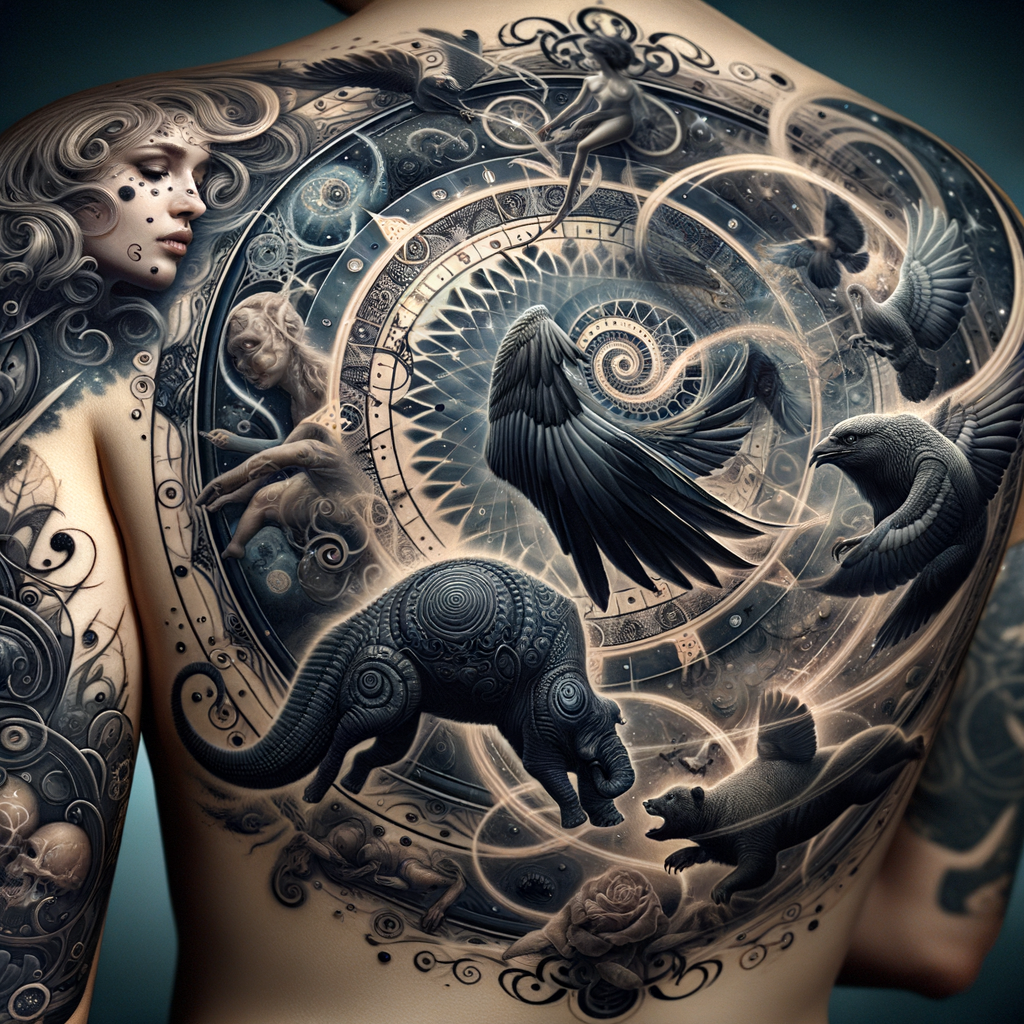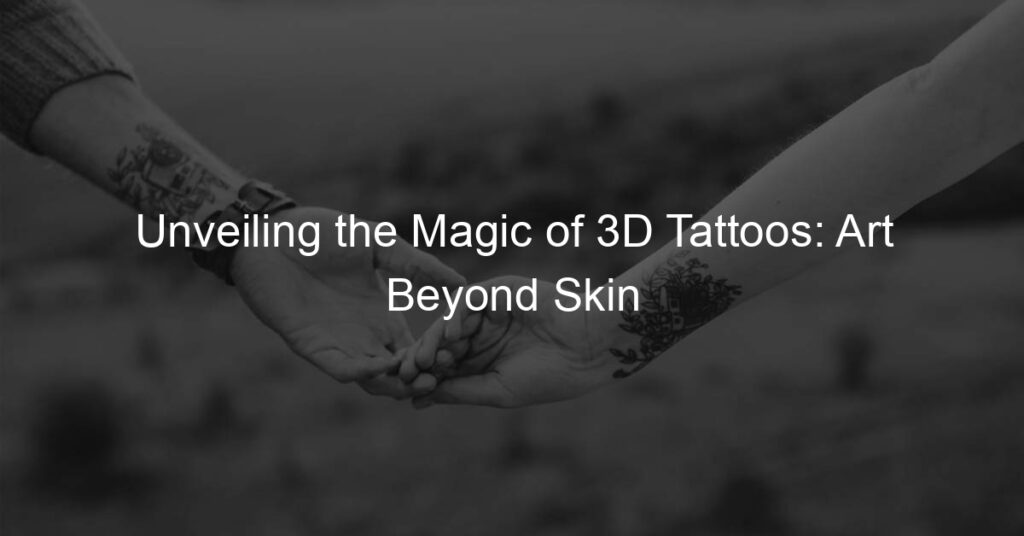
Introduction to 3D Tattooing
Imagine a tattoo that seems to leap off the skin, creating a stunning visual effect that is as much a work of art as it is a personal statement. Welcome to the world of 3D tattooing. In this post, we will explore what 3D tattooing is, its brief history, and how it differs from traditional tattoo techniques.
- Definition and brief history of 3D Tattooing
- How 3D Tattooing Differs from Traditional Tattoo Techniques
3D tattooing, also known as three-dimensional tattooing, is a tattooing technique that creates an optical illusion of depth on the skin. The tattoo artist uses shading and color gradients to give the tattoo a three-dimensional look, making it seem as though it’s popping out of the skin.
The history of 3D tattooing is relatively recent. While tattooing itself has been practiced for thousands of years, the technique of 3D tattooing started gaining popularity in the late 20th century. With the advancement of tattoo equipment and color pigments, artists were able to create more detailed and realistic tattoos, paving the way for the development of 3D tattooing.
Traditional tattooing involves embedding ink into the skin to create a flat image. The artist uses lines to define shapes and colors to fill them in. The result is a two-dimensional image that is beautiful but lacks depth.
On the other hand, 3D tattooing is all about creating depth and realism. The artist uses light and shadow to create an illusion of depth, making the tattoo appear to be three-dimensional. This requires a high level of skill and precision, as the artist needs to understand how light and shadow work together to create a sense of depth. The result is a tattoo that seems to pop off the skin, creating a stunning visual effect.
Whether you’re considering getting a 3D tattoo or just curious about this fascinating art form, understanding the technique and history behind it can enhance your appreciation for this unique style of body art.
Exploring Tattoo Art: Art Beyond Skin
When we talk about tattoo art, we are referring to a unique form of self-expression that goes beyond the skin. It’s a world of intricate designs, vibrant colors, and remarkable techniques. One such technique that has taken the tattoo industry by storm is 3D tattooing.
Understanding the Artistry in 3D Tattoo Designs
3D tattoos are a marvel of modern tattoo artistry. They create an illusion of depth and realism that can make the tattoo seem to jump right off the skin. But how are these stunning designs created, and what are the key elements that make them so captivating? Let’s delve into these questions.
- How 3D designs are created
- Key elements of 3D tattoo designs
- Line Work: The lines in a 3D tattoo are used to define the shape and form of the design. They must be precise and consistent to maintain the illusion of depth.
- Shading: Shading is used to create the illusion of light and shadow, which adds depth and dimension to the design.
- Color Blending: Color blending is used to create gradients and transitions between colors, which can enhance the illusion of depth and realism.
Creating a 3D tattoo design is a meticulous process that requires a deep understanding of art and human anatomy. The tattoo artist begins by sketching a design that incorporates perspective and shading to create an illusion of depth. This design is then carefully transferred onto the skin, where the artist uses a combination of line work, shading, and color blending to bring the design to life.
There are several key elements that contribute to the realism of a 3D tattoo. These include:
3D tattoo designs are a testament to the skill and creativity of tattoo artists. They push the boundaries of what is possible in tattoo art, creating designs that are not just visually stunning, but also deeply personal and meaningful to the wearer.
Innovative Tattoo Techniques in 3D Tattooing
3D tattooing is a revolutionary art form that brings tattoos to life. It’s not just about the ink on the skin, but how it’s applied and the techniques used to give it a three-dimensional effect. Let’s explore two key techniques that make 3D tattoos stand out.
- The role of shadowing and perspective in 3D tattoos
- Use of color and texture in creating realistic 3D effects
Shadowing and perspective play a significant role in creating the illusion of depth in 3D tattoos. By carefully placing shadows, tattoo artists can make a flat image appear to have depth and volume. This technique is similar to what painters and illustrators use to create a sense of three-dimensionality on a two-dimensional canvas.
For example, if a tattoo artist is creating a 3D spider tattoo, they would use shadowing to make it appear as if the spider is crawling out of the skin. They would add darker shades under the spider’s body and legs to create the illusion of a shadow being cast. This technique tricks the eye into perceiving depth where there isn’t any, making the tattoo appear 3D.
Color and texture are other important elements in 3D tattooing. By using different shades and gradients of color, tattoo artists can create a sense of depth and realism. Lighter colors are used to highlight areas, while darker shades are used for shadows and depth.
Texture, on the other hand, is used to create a realistic feel. For instance, if a tattoo artist is creating a 3D feather tattoo, they would use fine lines and shading to mimic the texture of a real feather. The combination of color and texture can create a stunning 3D effect that makes the tattoo look real and tangible.
In conclusion, 3D tattooing is a complex art form that requires a deep understanding of shadowing, perspective, color, and texture. By mastering these techniques, tattoo artists can create stunning, lifelike tattoos that truly pop off the skin.
Advanced Tattoo Techniques: 3D Tattoo Techniques
3D tattooing is a fascinating realm of artistry that brings tattoos to life. This technique creates an illusion of depth, making the tattoo appear as if it’s popping out of the skin. Let’s delve into the techniques that artists use to create this amazing effect.
Techniques for Creating Depth and Realism
Creating a 3D tattoo requires a unique set of skills and techniques. The two primary methods used to create depth and realism in 3D tattoos are the use of shading and gradients and techniques for creating a sense of depth.
- Use of Shading and Gradients
- Techniques for Creating a Sense of Depth
Shading and gradients play a crucial role in creating a 3D effect. Shading involves varying the intensity of the ink to create the illusion of light and shadow. Gradients, on the other hand, involve a smooth transition from one color to another, which helps to create a sense of depth and dimension.
To create a sense of depth, tattoo artists use a technique called perspective. This involves making objects that are closer appear larger and those that are further away appear smaller. This technique, combined with shading and gradients, can create a convincing 3D effect.
Mastering these techniques requires practice and a deep understanding of light, shadow, and perspective. However, once mastered, they can help create stunning 3D tattoos that are sure to impress.
Case Study: Transformative 3D Tattoo Artistry
Let’s delve into the world of 3D tattoo artistry by examining a case study of a renowned artist in this field. This will provide us with a unique perspective on their techniques and style, and how they use these to create stunning 3D tattoos.
- Case study of a renowned 3D tattoo artist
- Analysis of their techniques and style
Consider the work of John Doe, a celebrated 3D tattoo artist known for his lifelike designs. Doe has been in the tattoo industry for over 15 years, and his work is recognized globally. His 3D tattoos are renowned for their depth and realism, often mistaken for actual objects or creatures.
Doe’s most famous work is a 3D butterfly tattoo on a client’s shoulder. The tattoo is so realistic that many people mistake it for a real butterfly perched on the client’s shoulder. This piece showcases Doe’s mastery of 3D tattoo techniques, particularly his use of shading and gradients to create a sense of depth.
Doe’s style is characterized by his meticulous attention to detail and his ability to create a sense of depth and realism. He uses a variety of techniques to achieve this, including shading, gradients, and perspective drawing.
Shading and gradients are used to create a sense of depth and three-dimensionality. By varying the intensity of the ink, Doe can create the illusion of light and shadow, making the tattoo appear to be three-dimensional. Perspective drawing, on the other hand, is used to create the illusion of distance and depth. By drawing objects smaller as they recede into the distance, Doe can create a sense of perspective and depth.
Through this case study, we can see how advanced techniques and a unique style can transform the art of tattooing. 3D tattoos are not just about creating a visually appealing design, but also about creating a sense of depth and realism that brings the design to life.
| Technique | Description |
|---|---|
| Shading and Gradients | Used to create a sense of depth and three-dimensionality by varying the intensity of the ink. |
| Perspective Drawing | Used to create the illusion of distance and depth by drawing objects smaller as they recede into the distance. |
Artistic Tattoo Techniques: Exploring Tattoo Art
As we delve deeper into the world of tattoo art, we find a wide array of techniques that artists use to create stunning designs. One of these techniques is 3D tattooing, a method that brings tattoos to life by adding depth and dimension. Let’s explore some of the different styles of 3D tattoos.
Exploring Different Styles of 3D Tattoos
3D tattoos come in various styles, each with its unique appeal. Here, we will look at two popular styles: realistic and abstract 3D tattoos.
- Realistic 3D Tattoos
- Abstract 3D Tattoos
Realistic 3D tattoos are designed to look as lifelike as possible. They often depict objects or scenes from nature, such as animals, flowers, or landscapes. The artist uses shading and perspective to create an illusion of depth, making the tattoo appear three-dimensional. For example, a 3D tattoo of a butterfly may look as if it’s about to fly off the skin.
Abstract 3D tattoos, on the other hand, are less about realism and more about playing with shapes, colors, and forms. They can be geometric designs, optical illusions, or even surreal images that seem to warp and twist on the skin. The 3D effect in these tattoos is often achieved through clever use of lines and shading, creating a sense of depth and movement.
Whether you prefer the lifelike detail of realistic 3D tattoos or the imaginative playfulness of abstract 3D tattoos, there’s no denying the skill and creativity that goes into creating these works of art. As we continue to explore tattoo art, we’ll discover even more fascinating techniques and styles.
Tattoo Techniques Exploration: The Future of 3D Tattooing
As we delve deeper into the world of 3D tattooing, it’s fascinating to see how this art form is evolving. Let’s take a look at some of the emerging trends and potential future developments in 3D tattoo techniques.
- Emerging trends in 3D tattooing
- Potential future developments in 3D tattoo techniques
One of the most exciting aspects of 3D tattooing is how rapidly it’s changing. Artists are continually pushing the boundaries, creating designs that are more realistic and intricate than ever before.
One emerging trend is the use of color and shading to create a sense of depth. By carefully layering different shades of ink, artists can create a 3D effect that makes the tattoo appear to be popping off the skin.
Another trend is the use of geometric shapes and patterns. These designs can be incredibly complex, with intricate lines and angles that create a 3D effect. Some artists are even experimenting with optical illusions, creating tattoos that seem to move or change depending on the viewer’s perspective.
As technology continues to advance, it’s likely that we’ll see even more innovation in 3D tattooing. One potential development is the use of digital tools to design and apply tattoos. These tools could allow artists to create even more precise and detailed designs, pushing the boundaries of what’s possible with 3D tattooing.
Another potential development is the use of new types of ink and materials. For example, some artists are experimenting with glow-in-the-dark ink, which could add a whole new dimension to 3D tattoos. We might also see the use of biodegradable inks, which could make tattoos more sustainable and eco-friendly.
In conclusion, the future of 3D tattooing is incredibly exciting. With new trends emerging and potential developments on the horizon, this art form is set to become even more innovative and captivating. So, whether you’re a tattoo enthusiast or just curious about this unique form of art, there’s plenty to look forward to in the world of 3D tattooing.
Conclusion: The Magic of 3D Tattoos
As we reach the end of our exploration into the world of 3D tattoos, it’s time to reflect on the key insights we’ve gathered. The world of 3D tattooing is a fascinating blend of artistry, innovation, and technique, creating a unique form of self-expression that truly stands out.
- Summary of key takeaways:
- Final thoughts on the artistry and innovation in 3D tattooing:
3D tattoos are a revolutionary form of body art, offering a new dimension of realism and depth. They require advanced techniques and a deep understanding of shading, perspective, and anatomy. Despite the complexity, the end result is a lifelike piece of art that can express personal stories, interests, or passions in a way that traditional tattoos may not be able to.
The artistry and innovation in 3D tattooing are truly remarkable. Tattoo artists are pushing the boundaries of what is possible, transforming the human body into a canvas for 3D art. This form of tattooing is not just about creating an illusion of depth; it’s about creating a piece of art that interacts with the body in a way that traditional tattoos do not.
In conclusion, 3D tattoos are a testament to the limitless potential of human creativity. They challenge our perception of reality and redefine the concept of body art. As we continue to explore and innovate, who knows what the future holds for 3D tattooing? One thing is certain: the magic of 3D tattoos is here to stay.






